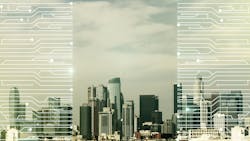Digitalization Strategies Are Key for CRE to Meet Sustainability Targets
Commercial buildings are responsible for 28% of global carbon emissions, more than even the auto industry. Yet unlike the automotive industry, the majority of commercial buildings that will exist in 2050 are already in existence today. So while we may think the future of sustainable real estate lies in shiny, new construction, it actually rests in successfully implementing sustainability initiatives in existing building stock and retrofitting assets.
Commercial real estate teams are working to establish sustainability goals across their organizations in order to address the climate challenge. But these teams face a unique challenge. CRE organizations face one of the most complex operating environments across the business landscape, relying on siloed teams who often report through different operating companies, with separate goals and incentives when it comes to operating and maintaining a profitable building.
A breakdown in communication across these varying teams hinders progress but it’s also where digitalization offers the most effective and efficient solution. By digitalizing workflows, CRE teams will report, collaborate and achieve their goals collectively to bring these siloed stakeholders into alignment. Real-time, cross-functional collaboration brings opportunities for operational improvement to the surface, allowing for visibility by all teams into reductions in cost, carbon and energy.
Split Incentives in Commercial Real Estate
The division of interests among building owners, operators and investors is often overlooked as a major impediment to progress. In this disjointed approach to decarbonization, individuals often seek to optimize for the core metrics of their specific department or position, such as carbon reduction, cost efficiency, energy consumption or tenant satisfaction in isolation and without considering how their own objectives may impact broader stakeholders.
The impact? Recent research shows that while two-thirds of organizations say they have some form of public carbon reduction commitment, only one-fifth say they are meeting or exceeding their goals. Siloed strategy and weak implementation is slowing the pace of progress.
A comprehensive and collaborative approach to decarbonization that involves all relevant stakeholders is essential. This can be facilitated by establishing robust internal governance systems that align objectives, finances, resources and responsibility for execution. In this way, sustainability goals—set at the corporate level—can be effectively communicated and implemented by those responsible at the building level. Those mandates can provide clarity about how the organization can begin to operationalize change in how buildings consume energy.
Benefits from Digitalization at Every Level
Digitalization is a necessary strategy to improve communication and decision-making across all roles within the organization, resulting in transformation and reduction in risk. With real-time, building level data in hand, CRE entities can enable significant change. Data collection and analysis allows building teams to respond to constantly changing operating conditions, unlocking operational excellence.
Digitalization also brings centralized access to critical building data, ensuring various stakeholders can view current operations and areas for improvement. Building Management system (BMS) data, meter data, billing history, occupancy information and even weather forecasts are all valuable insights to run an energy efficient building. With these details now readily available to all teams, standard operating procedures (SOP’s) can be established and harmonized throughout the business and more quickly make the needed changes to run an optimally performing building. With an increase in building managers and engineers nearing retirement according to the International Facility Management Association’s (IFMA), digitalization also holds the key to ensuring new team members can quickly onboard to review, assess and maintain building operations and performance progress.
Digitalization of building processes will support the need to meet the growing demands from regulatory bodies, investors and tenants who require accurate reporting on how buildings are performing against publicly made decarbonization targets. In cities across the country, laws such as those from New York City with Local Law 97, are requiring buildings to greatly reduce their emissions, from a 40% reduction by 2030 and 80% reduction by 2040. Clear data to support those reduction targets will be necessary to prevent the accumulation of fines and begin to document proven progress towards carbon reduction goals.
Beyond Savings, Sustainability Continues to Pay Back
Demonstrating proven progress is also supporting the growing tenant demand for sustainable spaces that reflect their own business’s climate goals. This increase has led to a 7.1% average rental premium for green-certified, class A office buildings according to real estate company JLL’s recent report. Attracting these tenants who seek quality green spaces will require CRE operators to adapt to digitalized internal processes to meet and improve benchmarking on building performance. In doing so, commercial buildings can garner certifications including Energy Star ratings, whose verification signals a building’s top performance among the top 25% of similar buildings nationwide, or the GRESB rating regarding how ESG issues are integrated into the management and practices of companies and funds.
3 Essential Steps to Maximize the Potential of Digitalization
With digitalization a priority for building teams, aligning on the right technology to support communication, collaboration and reporting will be important for ongoing success. In order to maximize digitalization strategies, CRE stakeholders must elevate their focus on data, actionable insights and team empowerment.
- Bring your team on the journey. People are the heart of real estate and will remain a central part of its success. People paired with technologies, such as artificial intelligence (AI) and machine learning, allow for instant decision-making supported by real-time access to operational data. Training for how to work with new technologies will be an important component of digitalization.
- Adopt a laser focus on predictive data. Every commercial office building is collecting thousands of data points every day, yet across the industry 90% of this data is not stored. Performance improvements can only happen with access to quality data. Prioritize technologies that can capture your building’s own proprietary data, alongside outside events impacting the building operations such as weather. Centralized access to granular data is the backbone of setting and meeting decarbonization targets.
- Utilize digital tools that promote action. With data now stored and analyzed for relevant trends and insights, direct action can be taken on an ongoing basis. Building engineers can act on informed, energy-efficient recommendations based on data-backed operational improvements tailored to their unique building to achieve targets. CRE teams should look to technologies that can mine building data to make predictive recommendations for demand management and energy efficiency.
Digitalization of workflows and predictive data analytics offer a viable solution to support building owners, managers and engineers to collectively meet their ESG targets. With the federal government outlining decarbonization targets for the built environment that include 65% reduction in GHG emissions by 2035 and 90% by 2050, now is the time for CRE teams to effectively collaborate and rethink their workflows.
About the Author

Lisa Rockefeller
Lisa Rockefeller is Chief Revenue Officer at Cortex Sustainability Intelligence, an industry-leading decarbonization platform tailored for commercial real estate.
